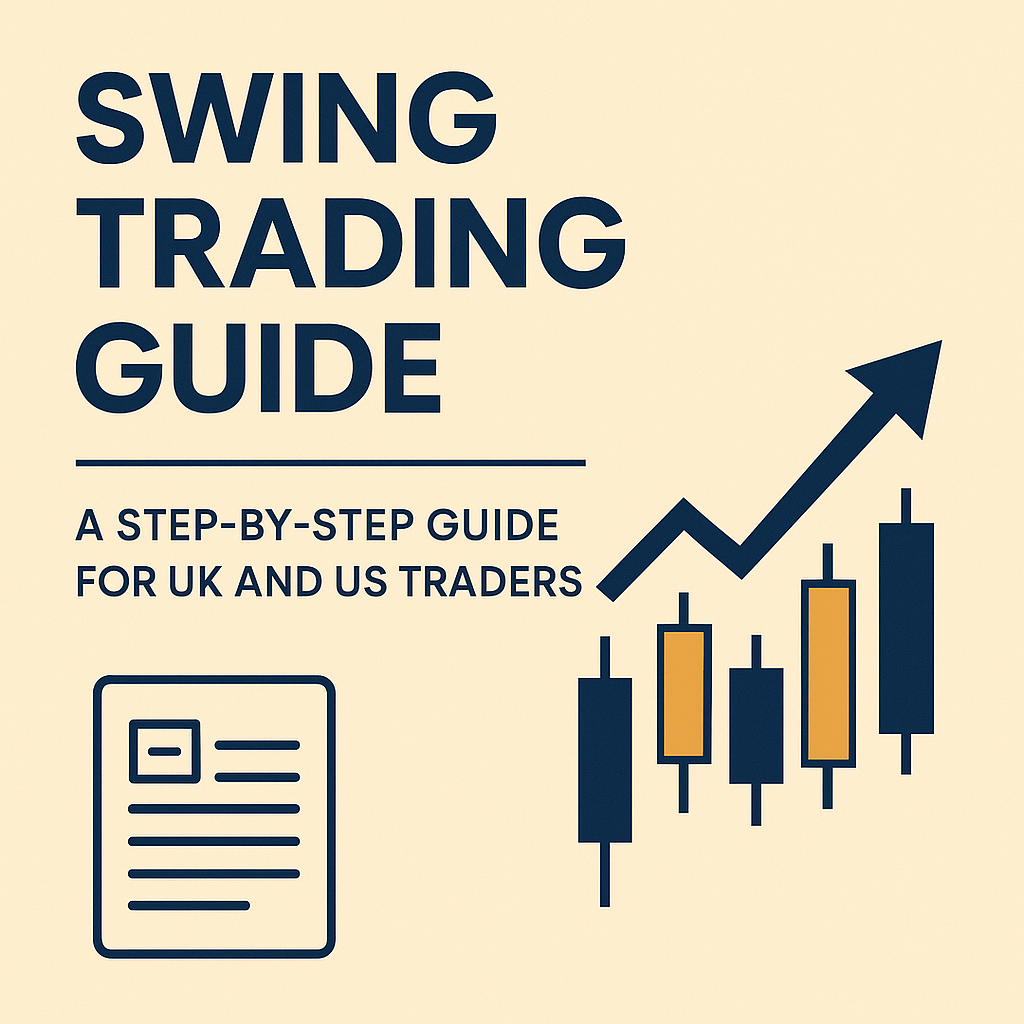Swing Trading Guide (UK & US): A Complete A–Z for Beginners and Intermediates
Primary keyword: swing trading guide. Also covers UK trading, US trading, for beginners, and strategies.
1) Why swing trading and who it suits
Swing trading aims to capture multi-day to multi-week moves in stocks, forex pairs, indices, and commodities. It sits between day trading and long-term investing. You hold positions overnight, but you don’t marry them for months. This style is popular with UK and US retail traders who have a day job but still want meaningful exposure to market moves.
- Not sure when to enter or exit a trade.
- Confused by indicators and conflicting signals.
- Unsure how UK vs US rules affect leverage, taxes, and broker choice.
- Risk management feels vague; losses spiral when trends reverse.
2) Definitions and core concepts
What is swing trading?
It’s a rules-based approach to trade the “swing” within a trend or range. You identify an area where the odds favour a move and hold through the bulk of that move, usually for 3–20 trading days.
Key terms
- Trend: General direction of price (up, down, or sideways).
- Support/Resistance: Price zones where demand or supply tends to slow or reverse moves.
- Pullback: Temporary move against the prevailing trend.
- Breakout: Price moving through a key level after consolidation.
- Risk/Reward (R:R): Potential profit versus potential loss on a trade (e.g., 2R means target twice your risk).
Timeframes and confirmation
Most swing traders analyse on daily charts for structure, look for entries on 4H/1H, and manage exits on daily/4H. Multi-timeframe analysis helps align entries with the higher-timeframe trend.
3) A step-by-step swing trading framework
- Screen the market: Build a watchlist of 20–50 instruments. Use simple filters: trend direction, proximity to support/resistance, average true range (ATR) for volatility.
- Define the bias: Uptrend (higher highs/lows) or downtrend (lower highs/lows). In ranges, focus on mean-reversion setups.
- Plan the trade: Mark entry trigger, stop loss, and targets before placing any order. Your plan must pass a minimum R:R (usually ≥ 2:1).
- Size the position: Risk a fixed % of equity per trade (commonly 0.5%–1%). Position size =
Account Risk ÷ (Entry − Stop distance). - Execute: Use limit or stop orders. Avoid chasing; let price come to your level.
- Manage: Move to breakeven only after structure confirms. Scale out near prior swing highs/lows or key fib/MA levels.
- Review: Journal the setup, execution, emotions, and outcome. Classify mistakes vs. variance.
4) Proven strategies (with examples)
Strategy A: Pullback to the 20/50 EMA
Idea: Trade in the direction of the daily trend. Wait for a pullback into the zone between the 20-EMA and 50-EMA, then enter when intraday momentum turns back with the trend.
Rules:
- Daily trend up (higher highs/lows) or down (lower highs/lows).
- Price touches the 20/50 EMA zone and prints a reversal candle (pin bar/engulfing) on 4H.
- Enter on break of the 4H reversal candle; stop below/above the swing.
- Targets at 1.5R, 2R, and prior swing high/low.
Example: GBP/USD uptrend. Price pulls back to the EMA zone near a former resistance turned support. A 4H bullish engulfing triggers entry. First target at 2R, final at daily swing high.
Strategy B: Breakout from a Tight Range
Idea: After low-volatility consolidation, breakouts can travel fast as trapped traders exit.
- Identify a 7–15 bar tight range on the daily chart (small ATR relative to 20-day average).
- Set a buy stop just above resistance or sell stop just below support.
- Initial stop on the opposite side of the range; partial profits at 1.5R to 2R.
- If a false break occurs, step aside and wait for a new structure.
Example: S&P 500 CFD compresses for two weeks. A clean close above the range triggers a momentum swing into earnings season.
Strategy C: Mean Reversion at Range Extremes
Idea: In sideways markets, fade moves at the edges when momentum wanes.
- Define a horizontal range on the daily chart with at least three touches on both sides.
- Look for RSI divergence or a loss of momentum at the edge.
- Enter on a 1H reversal pattern; stop outside the range; target midrange then opposite edge.
Example: EUR/GBP oscillates within a 250-pip box. Short near resistance with bearish divergence; scale out at the midline.
Position sizing example
Account £/$10,000. Risk per trade 1% = £/$100. Entry at 1.2700, stop at 1.2650 (50 pips). Value per pip = £/$2.0 to risk £/$100. So size = 0.2 mini lots (forex) or adjust shares/contracts to match.
5) Risk and trade management
- Risk a fixed %: 0.25%–1% keeps you in the game through losing streaks.
- Max concurrent risk: Cap total open trade risk at 2%–3% of equity.
- Correlations: Treat highly correlated pairs or sectors as one risk unit.
- Move stops with structure: Trail behind higher lows in uptrends or lower highs in downtrends, not just arbitrary pip counts.
- News risk: Reduce or hedge around high-impact releases (CPI, NFP, central bank decisions, earnings).
- Journaling: Tag each trade by setup type; drop the lowest-edge setups after a 20–30 trade sample.
6) Markets, instruments, and timeframes
| Market | Why Swing Traders Like It | Notes for UK Traders | Notes for US Traders |
|---|---|---|---|
| Stocks & ETFs | Clear trends, catalysts, earnings cycles | Share dealing, spread betting, or CFDs (FCA-regulated) available | Cash/margin accounts; pattern day trader (PDT) rule only for day trading |
| Forex (Majors/Minors) | 24/5 market, technicals work well | ESMA leverage caps (e.g., up to 30:1 majors), negative balance protection | Retail leverage typically up to 50:1 majors; FIFO and no-hedging rules with many US brokers |
| Indices (CFDs or Futures) | Broad market exposure, smooth trends | Index CFDs/spread bets are common | Index futures (e.g., E-mini, Micro E-mini) popular for swing |
| Commodities | Trend with macro cycles | Available via CFDs or ETCs/ETFs | Futures or commodity-linked ETFs |
7) UK vs US: rules, brokers, and taxes
Regulatory snapshot
- UK: Financial Conduct Authority (FCA) regulates retail trading. ESMA-style rules cap retail CFD/forex leverage (e.g., 30:1 majors, 20:1 minors), mandate margin close-out at 50%, and provide negative balance protection.
- US: Securities and Exchange Commission (SEC) and FINRA oversee securities; Commodity Futures Trading Commission (CFTC) and National Futures Association (NFA) oversee futures and retail forex. Many US forex brokers apply FIFO and restrict hedging. Typical max leverage for retail forex is up to 50:1 on majors and 20:1 on minors.
Broker considerations
Choose brokers that are directly authorised in your country. For the UK, look for an FCA firm reference number. For the US, confirm SEC/FINRA membership for securities and CFTC/NFA registration for futures/retail forex. Check product range, costs (spreads/commissions), overnight financing, platform quality, and customer support.
Order types and margin
- UK: Spread betting and CFDs allow swing trading with lower capital outlay, but financing charges apply overnight. Share dealing avoids financing but ties up more capital.
- US: Margin accounts let you short and use leverage for equities; PDT rule affects frequent day trading, not typical multi-day swing trades. For futures, margin is set by exchange/broker and changes with volatility.
Tax high-level pointers (not advice)
- UK: Share dealing usually falls under Capital Gains Tax (CGT). Spread betting can be tax-free for many UK residents, but rules can change and circumstances vary. Dividend and interest rules also apply.
- US: Capital gains differ by holding period (short-term vs long-term). Section 1256 may apply to certain futures with 60/40 treatment. Wash sale rules affect equities and options.
Always consult a qualified tax professional for your situation. This guide is educational only.
8) Checklists, templates, and tips
Pre-trade checklist
- Is the higher-timeframe trend clear?
- Is there a clean level or structure for the setup?
- Defined entry, stop, and at least 2:1 target?
- News/earnings risks checked?
- Position size calculated for fixed % risk?
Journal template
- Setup tag: Pullback / Breakout / Mean reversion
- Market: e.g., GBP/USD, AAPL, FTSE 100
- Entry/Stop/Targets: Numbers and screenshots
- Reasoning: What conditions were met?
- After-action: Was the plan followed? What to improve?
Common mistakes to avoid
- Using oversized stops because the idea feels “certain.”
- Moving to breakeven too early and getting wicked out.
- Trading ranges with trend rules and vice versa.
- Ignoring correlations and doubling risk unintentionally.
- Revenge trading after a loss.
Edge boosters
- Focus on one or two setups and master them.
- Trade during sessions that move your market (e.g., London overlap for major FX pairs).
- Use alerts to avoid staring at screens; let price come to your levels.
- Backtest 50–100 samples per setup before risking real capital.
9) FAQs
Is swing trading good for beginners?
Yes, because you make fewer decisions than day trading and can plan calmly. Start small, focus on one market, and log every trade.
How much capital do I need?
Enough to risk 0.5%–1% per trade and still make the work worthwhile. You can begin with smaller accounts and scale as your process proves out.
Which indicators work best?
Price action, moving averages (20/50 EMA), RSI, and ATR for volatility. Keep it simple; consistency beats complexity.
Does the US PDT rule affect swing trading?
The pattern day trader rule targets frequent intraday trading. Typical multi-day swing trades in a margin account are not constrained by PDT, but always confirm with your broker.
10) Key takeaways & next steps
- Swing trading fits traders who want structured, multi-day opportunities without intraday noise.
- Stick to one or two simple setups: pullbacks in trend and breakouts from tight ranges.
- Protect capital with fixed % risk, structure-based stops, and correlation awareness.
- Choose a regulated broker in your country and understand leverage, margin, and tax basics.
- Journal, review, and refine. Your edge grows from measurement and iteration.
Call to action: Pick one setup from this swing trading guide, backtest 50 trades, and only then add size. Keep learning and improve your process one step at a time.
Trusted Brokers & Tools
Use the buttons below to explore brokers and tools. Always trade responsibly and read the full terms on each site.





